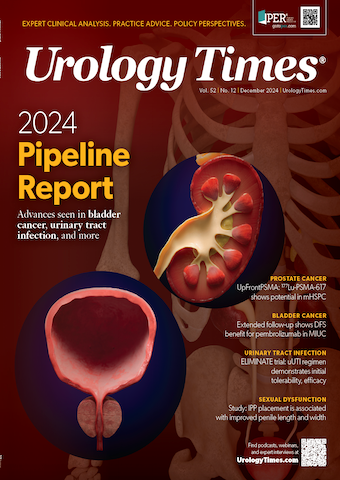News
Article
Urology Times Journal
Rogaratinib plus atezolizumab shows encouraging safety, efficacy in urothelial carcinoma
Author(s):
Key Takeaways
- Rogaratinib and atezolizumab combination therapy shows promising efficacy in urothelial carcinoma, with a 53.8% overall response rate, independent of PD-L1 or FGFR3 status.
- The recommended phase 2 dose is rogaratinib 600 mg with atezolizumab 1200 mg, achieving a median progression-free survival of 6.1 months.
The recommended phase 2 dose was determined to be rogaratinib at 600 mg in combination with atezolizumab at 1200 mg.
The combination of rogaratinib, a pan-FGFR inhibitor, plus atezolizumab (Tecentriq), a PD-L1 inhibitor, demonstrated a manageable safety profile with promising initial efficacy in patients with locally advanced or metastatic urothelial carcinoma, irrespective of PD-L1 expression or FGFR3 gene alteration status, according to data from the phase 1b FORT-2 trial (NCT03473756) published in JAMA Oncology.1
At the RP2D, the overall response rate was 53.8%.

“The major problem with immunotherapy was it works great for some patients with bladder cancer, but the response rates never exceeded 25% with immunotherapy by itself. Our main focus is to try to understand the resistance to immunotherapy,” explained lead author Randy F. Sweis, MD, an assistant professor of medicine at the University of Chicago Medicine Comprehensive Cancer Center, in a news release on the findings.2 “In 2016, we published studies showing that the tumors with FGFR3 mutations have no T cell infiltration, which led to the logical conclusion that blocking the FGFR pathway could make more patients responsive to immunotherapy.”
For the study, patients received either rogaratinib 600 mg (70%, n = 26) or rogaratinib 800 mg (30%, n = 11) twice daily in combination with intravenous atezolizumab 1200 mg every 21 days. The median duration of treatment was 1.4 months in the rogaratinib 800-mg cohort and 4.1 months in the rogaratinib 600-mg cohort.
Regarding safety, 73% of patients (n = 27) in the study experienced a treatment-emergent adverse event (TEAE) of grade 3 or higher. The most common TEAEs included diarrhea (62%), hyperphosphatemia (51%), and fatigue (41%). In the rogaratinib 600-mg cohort, 27% of patients (7 of 26) experienced a TEAEs leading to treatment discontinuation compared with 55% of patients (6 of 11) in the rogaratinib 800-mg cohort.
The recommended phase 2 dose (RP2D) was determined to be rogaratinib at 600 mg in combination with atezolizumab at 1200 mg.
At the RP2D, the overall response rate was 53.8%, which included a complete response in 15% of patients (n = 4). Overall, 79% of responders (n = 11) had low PD-L1 expression and 86% of responders (n = 12) did not have an FGFR3 gene alteration. The ORR was similar for patients with positive PD-L1 tumors vs negative PD-L1 tumors (40% vs 44.4%).
The median time to response was 2.1 months (95% CI, 2.0-2.1), and the disease control rate was 76.9%. At the time of data collection, the median duration of response had not yet been reached, with some complete response still ongoing.
Among all patients, the median progression-free survival (PFS) was 6.1 months (95% CI, 3.2-9.8), translating to a 27% PFS rate at 24 months. The median PFS was 7.5 months for rogaratinib 600-mg cohort and 2.1 months for the rogaratinib 800-mg cohort.
The median overall survival (OS) was 12.0 months, translating to a 31% OS rate at 24 months. The median OS was 16.8 months in the rogaratinib 600-mg arm and 8.3 months in the rogaratinib 800-mg arm.
The median time to maximum plasma concentration was 1.2 hours for patients who received rogaratinib 600 mg and 1.9 hours for patients who received rogaratinib 800 mg.
In total, the nonrandomized, open-label FORT-2 trial included 37 patients with locally advanced or metastatic urothelial carcinoma who had FGFR1/3 mRNA overexpression and were ineligible for cisplatin-based chemotherapy. Patients were enrolled across 30 sites in Asia, Europe, and North America. The median age of participants was 75 years (range, 47-85), and 87% of patients were male.
The primary end points were safety, tolerability, and the determination of a RP2D. Secondary end points were to assess efficacy and pharmacokinetics.
Overall, the authors concluded, “This phase 1b nonrandomized clinical trial demonstrates that rogaratinib can be safely combined with atezolizumab to treat [urothelial carcinoma] with FGFR1/3 overexpression. A favorable ORR of 53.8% was observed, which was not dependent on FGFR3 gene alteration or PD-L1 status, broadening the population of patients who may benefit.”1
References
1. Sweis RF, Gajate P, Morales-Barrera R, et al. Rogaratinib plus atezolizumab in cisplatin-ineligible patients with FGFR RNA-overexpressing urothelial cancer: The FORT-2 phase 1b nonrandomized clinical trial. JAMA Oncol. 2024:e243900. doi:10.1001/jamaoncol.2024.3900
2. New combination treatment brings hope to patients with advanced bladder cancer. News release. University of Chicago Medical Center. September 19, 2024. Accessed September 24, 2024. https://www.newswise.com/articles/new-combination-treatment-brings-hope-to-patients-with-advanced-bladder-cancer
































